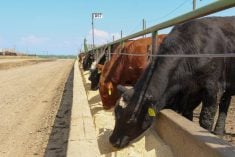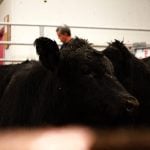During the first week of January, Alberta packers were buying fed cattle on a dressed basis in the range of $363-$365 per hundredweight delivered.
This was down marginally from the price range of $368-$370/cwt. during the week of December. In Kansas and Texas, live prices were US$171/cwt., down US$4/cwt. from 30 days earlier. U.S. packers retrained the slaughter pace from September through November. This resulted in lower fed cattle marketings from feedlots on both sides and border and carcass weights are now sharply above year-ago levels.
Wholesale choice beef prices reached a high of US$308/cwt. in September and declined to $291/cwt. during the last week of December 2023. We now find that lower wholesale prices have enhanced demand and the U.S. December slaughter finished above year-ago levels.
Read Also

Gentle treatments for pain in the neck
Heading toward year-end, people unknowingly tense up against the cold and busyness, causing neck pain that can often be treated with appropriate support and gentle mobility, athletic therapist Kathlyn Hossack says.
Prices for heavier replacements have softened throughout the fall of 2023 and may grind lower during the first couple of months of 2024. Feedlot margins are hovering in negative territory and cattle are backed up in feedyards. Prices for calves under 700 pounds have remained firm. This is largely dependent on the demand for grass cattle as yearling supplies this fall will be historically tight.
U.S. cattle on feed inventory as of Dec. 1, 2023, totalled 12 million head, up 2.8 per cent or 333,000 head from the Dec. 1, 2022, number of 11.693 million head. Feedlot marketings during November 2023 were 1.751 million head, down 7.5 per cent or 140,000 head from November of 2022.
Finally, feedlot placements in the weight categories over 800 lbs. were relatively unchanged from year-ago levels while placements under 800 lbs. were down 40,000 head. U.S. feedlots are backed up with market-ready supplies. U.S. carcass weights at the end of December were 15 lbs. above year-ago levels. Trade estimates suggest there are 250,000 to 300,000 head of market-ready cattle backed up in U.S. feedlots. Fed cattle supplies are not tight.
Placements
Cattle-on-feed inventories in Alberta and Saskatchewan on Dec. 1, 2023, were unchanged from year-ago levels. However, fed cattle marketings in the two provinces during November were down 10 per cent from November of 2022.
Alberta and Saskatchewan feedlot placements during November in the heavier weight categories were higher than last year while placements under 700 lbs. were down sharply from November 2022. Feedlots in Western Canada are in a similar situation as their U.S. counterparts. Market-ready supplies of fed cattle at the end of December 2023 were up about 30,000 head from year-ago levels. Alberta carcass weights for steers and heifers were up 30 lbs. from last year during the last week of 2023.
Given the backlog of market-ready supplies on both sides of the border, demand for backgrounded cattle will soften during January and February. During the last half of December, larger frame lower flesh 800-lb. Simmental steers in Alberta were selling for $305/cwt.
The break-even pen closeout price for June on a live basis is nearly $250/cwt. The June live cattle futures are reflecting a forward price of $224/cwt. These 800-lb. steers are coming in with a bill of $360. The market for backgrounded cattle is not sustainable moving forward unless we see a significant rally in the June and August live cattle futures.
Rebuilding
Historical data tells us that U.S. and Canadian cow-calf producers need one full year of historically high prices before herd rebuilding begins. Feeder cattle prices reached historical highs in 2023; therefore, herd rebuilding will begin in 2024. There was no signal from the slaughter data or auction market receipts that producers were holding back on heifers in the U.S. or Canada.
The U.S. calf crop during 2022 was 34.5 million head; the U.S. 2023 calf crop was estimated at 33.8 million head and the 2024 calf crop will likely finish near 33.5 million head. In the U.S., there will be 500,000-600,000 head of heifers held back for breeding in 2024.
Trade estimates suggest there will be 40,000-50,000 head of heifer retention in Canada. Most of this will occur in western Alberta but it also depends on pasture conditions and weather, of course. The first year-over-year increase in the calf crop in Canada and the U.S. will occur in 2025.
Yearling supplies this fall will be historically tight, which should cause the feeder cattle futures to retest the 2023 September highs. At the time of writing this article, the August 2024 feeder cattle futures were at $249. There is potential upside to the $300 area. The market will need to ration demand through higher prices.
Finishing feedlots are aware of this situation and many operations have placed calves under 500 lbs. in backgrounding lots. During the spring, the farmer-cattle producers shopping for grassers will have stiff competition from the finishing feedlot.
During the first quarter of 2024, the fed cattle market and prices for backgrounded cattle will likely grind lower. Once the backlog of market-ready supplies has been absorbed, fed cattle prices will likely percolate higher. This will likely occur in the summer. Prices for lighter calves are expected to hold value and trend higher in the second and third quarters.
















